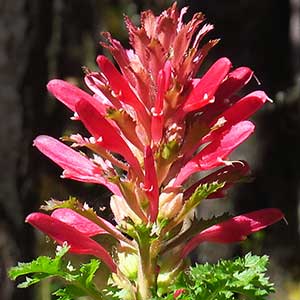Pedicularis densiflora
Pedicularis furbishiae
Indian warrior, warrior's plume
Furbish lousewort, Furbish's lousewort
basal 1–10, blade lanceolate, 30–200 x 20–70 mm, 2(or 3)-pinnatifid, margins of adjacent lobes nonoverlapping or extensively overlapping distally, 1-serrate, surfaces glabrous, hispid, or downy;
cauline 4–20, blade lanceolate, 15–250 x 5–100 mm, 2-pinnatifid, margins of adjacent lobes nonoverlapping or extensively overlapping distally, serrate, surfaces glabrous, hispid, or downy.
basal 4, blade lanceolate to elliptic, 70–130 x 35–50 mm, 2-pinnatifid, margins of adjacent lobes nonoverlapping or slightly overlapping distally, serrate, surfaces hispid;
cauline 7, blade lanceolate to elliptic, 20–90 x 8–35 mm, 1- or 2-pinnatifid, margins of adjacent lobes nonoverlapping or slightly overlapping distally, serrate, surfaces hispid.
simple, 1–5, exceeding basal leaves, each 10–50-flowered;
bracts lanceolate to trullate, 10–35 x 3–5 mm, undivided or 1-pinnatifid, proximal margins entire, distal 1- or 2-serrate, surfaces glabrous.
simple or paniculate, 1–4, exceeding basal leaves, each 3–30-flowered;
bracts trullate, 8–13 x 7–10 mm, undivided or pinnatifid, margins serrate to 2-serrate, surfaces hispid.
2–4 mm.
1–3 mm.
calyx 9–18 mm, downy to tomentose, lobes 5, triangular, 3–4 mm, apex entire, ciliate;
corolla 23–43 mm, tube dark red, purple, or orange-yellow, rarely white, 8–18 mm;
galea dark red, purple, or orange-yellow, rarely white, 15–25 mm, beakless, margins entire medially and distally, apex straight;
abaxial lip dark red, purple, or orange-yellow, rarely white, 8–15 mm.
calyx 5–12 mm, hispid-glandular, lobes 5, narrowly triangular, 3–4.5 mm, apex entire or dentate, glabrous;
corolla 14–19 mm, tube yellow, 8–10 mm;
galea yellow, apically sometimes tinged red, 6–8.5 mm, beakless, margins entire medially, 1-toothed distally, apex arching slightly over abaxial lip;
abaxial lip yellow with apex sometimes tinged red, 7–7.5 mm.
= 16.
Pedicularis densiflora
Pedicularis furbishiae
Scarlet corollas with an undomed, toothless galea and two- or three-pinnatifid leaves are diagnostic of Pedicularis densiflora. This species occurs in forested subalpine regions of southern Oregon, western slopes of the Sierra Nevada, and the Coast Ranges of California south to Baja California. Herbarium records indicate northern populations of P. densiflora occur at higher elevations than do more southern populations.
(Discussion copyrighted by Flora of North America; reprinted with permission.)
Discovered in 1880, and at one time believed extinct, Pedicularis furbishiae was rediscovered in 1974 during an environmental impact survey for a proposed dam on the St. John's River and thereafter was placed on the Federal Register under the Endangered Species Act (L. W. Macior 1981). Metapopulation dynamics suggest that an ecologically intact watershed is required for long-term persistence (E. S. Menges 1990). A recovery strategy has been adopted for this species in New Brunswick (Furbish's Lousewort Recovery Team 2006; Environment Canada 2010). Pedicularis furbishiae is in the Center for Plant Conservation’s National Collection of Endangered Plants.
(Discussion copyrighted by Flora of North America; reprinted with permission.)


